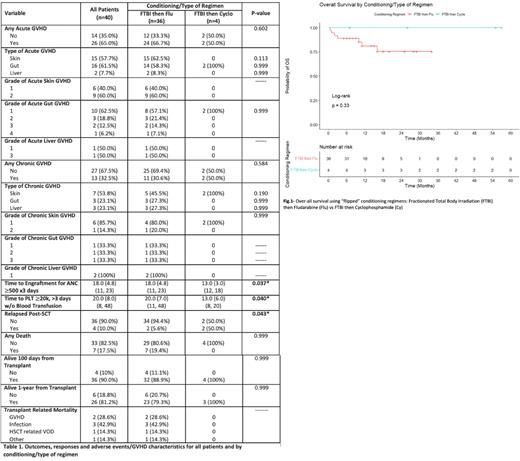Abstract
Introduction:
Use of Fludarabine (Flu) or Cyclophosphamide (Cy) followed by fractionated total body irradiation (FTBI) as conditioning regimens have been well-studied in allogeneic hematopoietic stem cell transplant (allo-HSCT) yielding good engraftment, low mortality and clinically significant graft versus host disease (GVHD) rates.
However, there is currently no data using a "flipped" conditioning strategy of FTBI followed by Fludarabine (FTBI/Flu) pre-transplant. There's also limited data using FTBI then Cy (FTBI/Cy).
Due to logistics and with approval from our investigational review board/patient consent-process, we have started using flipped conditioning strategies with adjustment to the timing of donor stem cell infusion.
We now report outcomes and safety data using "flipped" conditioning regimens: FTBI/Flu (has not been reported before) and FTBI/Cy.
Methods:
This retrospective chart review included 18 years, male/female patients with any benign or malignant hematologic diseases who underwent allo-HSCT at our institution using FTBI/Flu or Cy (2015-2021). Primary objectives include over-all survival (OS) and event-free survival (EFS) since transplant, stratified by FTBI/Flu and FTBI/Cy, transplant type, disease risk index (DRI) and stage of disease. Secondary objectives include patient characteristics, GVHD/survival rates and time to engraftment. Two-sided p value ≤0.05 was significant.
RESULTS:
In 40 patients, 36 underwent FTBI/Flu, 4 FTBI/Cy, median age 48.5 years, about equal male/female, 38.9% Hispanic in the FTBI/Flu group and 75% in FTBI/Cy (n=0.02). 50% had AML, 36.1% ALL in the FTBI/Flu group while 100% had ALL in FTBI/Cy (n=0.18).
In the FTBI/Flu group, 68.4% had CR1, 23.7% had CR2/3 at transplant vs 75% CR1 and 25% CR 2/3 in FTBI/Cy (n=0.99). 50% had intermediate and 22.2% had high DRI in FTBI/Flu; 75% had intermediate and 25% had high DRI in FTBI/Cy (n=0.65).
13.9% had MSD, 26.1% MUD and 50% Haplo in the FTBI/Flu group vs 75% MSD and 25% MUD transplant in FTBI/Cy (n=0.01).
97.2% used post-transplant cyclophosphamide/tacrolimus/mycophenolate as GVHD prophylaxis in the FTBI/Flu group while 100% used Tacrolimus/methotrexate in the FTBI/Cy group (n=0.001).
In terms of outcomes and adverse events/GVHD, in the FTBI/Flu group, median time to neutrophil engraftment was at 18 days vs 13 days (FTBI/Cy) (n=0.037). For platelets, median engraftment was 20 days (FTBI/Flu) vs 13 days (FTBI/Cy) (n=0.04). 5.6% had relapsed disease post-transplant (FTBI/Flu), none in the FTBI/Cy group (n=0.04), In the FTBI/Flu group, 88.9% were alive at d+100 vs 100% in FTBI/Cy (n=0.99). 79.3% were alive after 1 year in the FTBI/Flu group vs 100% in FTBI/Cy (n=0.99). Death in the FTBI/Flu group was attributed to GVHD (28.6%), infection (42.9%) and VOD (14.3%)
As for GVHD rates, 66.7% FTBI/Flu vs 50% FTBI/Cy had any grade (G), any type, acute GVHD (p=0.6). Among the 14 FTBI/Flu patients with acute gut GVHD, 14.3% experienced G3 while 1 of the 2 patients with acute liver GVHD had G3. No G4 noted. Meanwhile, 0% of patients in the FTBI/Cy group had any G3/4 acute GVHD. 30.6% FTBI/Flu patients had any grade, any type chronic GVHD vs 50% in FTBI/Cy patients (p=0.58). In the 3 FTBI/Flu patients with chronic gut GVHD, 33.3% had G3, none with G4. No G3/4 chronic GVHD noted in the FTBI/Cy group (Table 1).
In the over-all population since transplant, 3y OS was 78.2% with 3y-EFS of 69.3%. If stratified by conditioning, FTBI/Flu 2y-OS was 75.3% vs 100% in FTBI/Cy (p=0.33) while FTBI/Flu 2y-EFS was 72.2% vs 50% in FTBI/Cy (p=0.39) (Fig 1).
When stratified by transplant type, 3y OS was 100% for MSD, 61.2% MUD while 2y OS was 80% in Haplo (p=0.2). 3y EFS was 58.3% in MSD, 61.2% in MUD and 2y EFS was 74.1% in Haplo (p=0.79). No notable difference was noted when OS and EFS were stratified via DRI (Intermediate: 3y OS 75.4%, 3y EFS 67.8%; High: 2y OS 88.9%, 2y EFS 77.8% [p=0.69-0.8]) and stage of disease at transplant (CR1 3y OS 80.7%, CR 2/3 2y OS 83.8% and CR1 3y EFS 70.8%, CR 2/3 2y EFS 74.1% [p=0.47-0.7]).
CONCLUSIONS:
Given most of our patients had intermediate/high DRI, using flipped conditioning strategies yielded appreciable 3y-OS (78.2%) and EFS (69.3%), even when further stratified based on conditioning types, DRI, disease status and stage at treatment.
Based on our data, using FTBI followed by Flu or Cy appears to be a safe strategy if needed, and did not show significantly more toxicity or inferior outcomes.
Disclosures
Chaudhary:Oncotartis: Consultancy; Pancella: Consultancy; Angeles Therapeutics: Consultancy, Current equity holder in private company; Moderna: Current equity holder in publicly-traded company; Celldex: Current equity holder in publicly-traded company; TCR2: Current equity holder in publicly-traded company; Allogene: Current equity holder in publicly-traded company; Athelas: Consultancy. Yaghmour:USC: Current Employment.
Author notes
Asterisk with author names denotes non-ASH members.


This feature is available to Subscribers Only
Sign In or Create an Account Close Modal